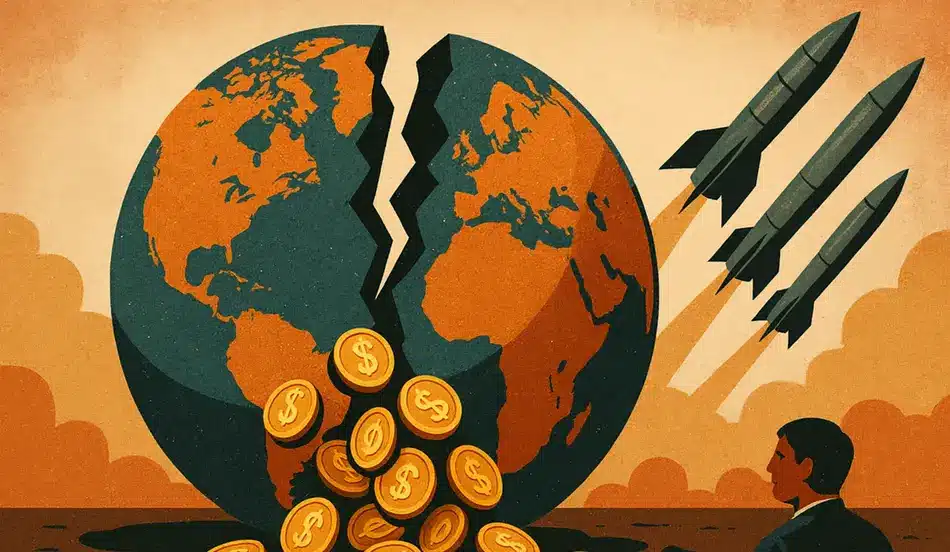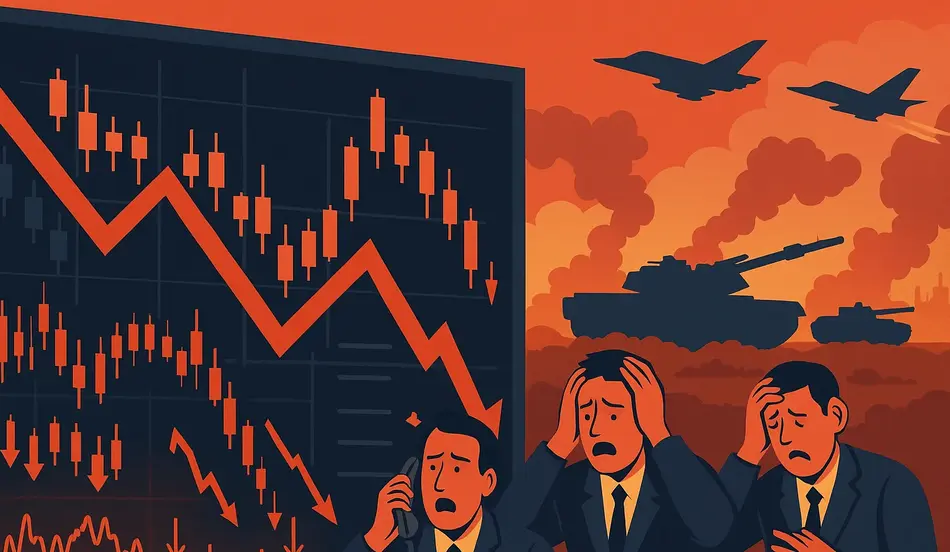The notion that war is “good for business” has persisted in financial circles for decades. As conflicts in Ukraine, Gaza, and recent tensions between Israel and Iran dominate headlines, many investors wonder how these geopolitical crises might affect economic output and financial markets. Despite the common belief that military spending stimulates economic growth, comprehensive research spanning hundreds of conflicts reveals a far more complex and typically negative relationship between warfare and economic prosperity.
This analysis examines the true economic impact of war based on extensive historical data, challenging the oversimplified view that conflict generates positive financial outcomes.
How War Affects National Economic Output
The GDP Paradox During Wartime
While some studies have identified positive impacts on GDP during wartime, these findings often reflect a narrow perspective focused primarily on the United States—a country that hasn’t experienced major conflict on its soil since 1865. The apparent economic boost comes from:
- Increased government military spending
- Higher employment in defense sectors
- Greater utilization of capital assets
- Innovation driven by military necessity
The United States experienced a remarkable 72% GDP growth from 1940 to 1945 during World War II, seemingly supporting the “war is good for the economy” argument. However, this represents an exceptional case rather than the norm.
The Reality for Most War-Affected Nations
Research by the European Bank for Reconstruction and Development analyzing over 700 conflicts from 1816 to 2014 reveals a starkly different picture:
- Countries fighting wars on their own territory saw an average 9% decline in GDP per capita
- The median decline was 3% relative to pre-war levels
- In the 20 most severe cases, GDP per capita dropped between 40-70%
For context, the U.S. GDP decline during the 2008 financial crisis was only 4.3%, demonstrating how devastating war’s economic impact typically is.
Learn more about global economic trends at the World Economic Forum
Five Critical Ways War Damages Economic Foundations
1. Devastating Human Capital Losses
Wars significantly impact a country’s labor force through:
- Direct loss of life among working-age population
- Refugee displacement and emigration
- Declining birth rates (typically 1.5 percentage points lower than comparable economies)
- Continued population growth suppression (0.5 percentage points lower even 5 years post-conflict)
These demographic shifts create long-term economic challenges that persist well beyond the conflict’s end.
2. Physical Infrastructure Destruction
When conflict occurs within a country’s borders, the damage to physical capital is extensive:
- Manufacturing facilities become damaged or abandoned
- Agricultural land and equipment become unusable
- Transportation infrastructure suffers significant disruption
- Housing and commercial buildings face destruction
This destruction of capital stock severely limits productive capacity and requires massive investment to rebuild—investment that often isn’t available in war-torn economies.
3. Trade Disruption and Financial Isolation
War significantly impacts a country’s integration with the global economy:
- Both imports and exports typically decline sharply
- External deficits widen by an average of 5 percentage points of GDP
- Supply chains become disrupted or completely severed
- International sanctions often compound these challenges
Ukraine’s experience demonstrates this reality—transforming from one of the world’s largest crop exporters to one of the most food-insecure nations within a year of Russia’s invasion.

4. Capital Flight and Investment Collapse
The uncertainty created by conflict drives away both domestic and foreign investment:
- Foreign direct investment typically plummets
- Domestic investors seek safer havens abroad
- Capital needed for rebuilding becomes scarce
- Long-term growth potential diminishes
This investment drought makes economic recovery particularly challenging, even after hostilities end.
5. Fiscal and Monetary Deterioration
To finance war efforts, governments typically:
- Increase sovereign debt (rising an average of 47 percentage points of GDP)
- Raise taxation levels significantly
- Often resort to inflationary monetary policies
- Face higher default risks on existing obligations
Countries fighting on their own territory experience a median 8 percentage point increase in inflation compared to pre-war trends, with extreme cases leading to hyperinflation.
Explore how conflicts affect global markets at the Financial Times
Global Economic Spillover Effects
The economic impact of war extends far beyond directly involved nations:
- Countries closest to conflicts see an average 10% decrease in GDP growth
- Nearby nations experience a 5% increase in inflation rates after 5 years
- Even distant countries face approximately 2% higher inflation
- Disruptions to key commodity production and transportation affect global prices
The Kiel Institute’s “Price of War Calculator” demonstrates that a conflict in Iran could cost the global economy more than double what it would cost Iran itself over a five-year period, primarily due to oil supply disruptions.
🚀 Secure Your Future with Resilient Jobs on WhatJobs
Global conflicts are reshaping economies and industries — is your career ready to adapt?
Discover essential opportunities in Defense, Logistics, Infrastructure, and Emergency Services that remain strong even during economic volatility.
WhatJobs connects you with high-impact, recession-resistant roles built for uncertain times.
👉 Explore resilient job sectors now — and protect your career path.Financial Markets During Wartime: Complex and Unpredictable
Stock Market Performance During Conflicts
The relationship between stock markets and warfare is particularly nuanced:
- Initial negative reactions typically occur at the onset of conflicts
- Recovery periods vary widely (maximum 307 days, average 41 days for S&P 500 since Pearl Harbor)
- Performance during major wars shows inconsistent patterns:
- Markets declined during World War I
- Markets showed positive returns during World War II and the American Civil War
- No direct correlation exists between valuations and post-WWI American conflicts
Surprisingly, some of the strongest performing sectors during World War II had little connection to war efforts, contradicting conventional wisdom about “defense stock” outperformance.
The Devastating Potential for Investors
While U.S. markets have historically weathered conflicts well due to geographical isolation, investors in war-affected countries have faced catastrophic outcomes:
- Chinese investors experienced asset expropriation in the 1940s
- Japanese and German equity markets suffered near-total wipeouts after WWII
- Ukraine’s stock market essentially ceased functioning after Russia’s invasion
Even traditional “safe haven” assets like gold show only temporary appreciation during conflicts before normalizing, highlighting the complex interplay of economic factors during wartime.
FAQ: Economic Impact of War
How does the economic impact of war differ between countries where fighting occurs versus those that are geographically removed from conflict?
The economic impact of war varies dramatically based on where the fighting takes place. Countries experiencing conflict on their own territory suffer an average 9% decline in GDP per capita, with damage to infrastructure, population displacement, and capital flight creating long-term economic challenges. In contrast, countries geographically removed from conflict—particularly those supplying military equipment without facing domestic destruction—may experience short-term GDP growth due to increased government spending and manufacturing. However, even these nations typically face inflation increases and supply chain disruptions that offset many economic benefits.
Does increased military spending during wartime actually create sustainable economic growth?
While increased military spending during wartime can temporarily boost GDP figures through government expenditure and employment creation, research across hundreds of conflicts shows this rarely translates to sustainable economic growth. The apparent economic boost often comes with significant downsides: sovereign debt increases by an average of 47 percentage points of GDP, inflation rises substantially, and resources are diverted from productive investments. Studies by the European Bank for Reconstruction and Development demonstrate that half of analyzed wars resulted in diminished economic output even 25 years after conflicts ended, indicating that military spending typically creates a short-term illusion of growth rather than sustainable economic development.
How do stock markets typically perform during major conflicts, and which sectors show resilience?
Stock market performance during conflicts shows no consistent pattern across different wars. While markets typically experience an initial negative reaction to geopolitical shocks, recovery periods vary widely—from just days to several years depending on the conflict’s nature and broader economic conditions. Contrary to popular belief, traditional “defense stocks” don’t always outperform during wartime, with historical analysis showing that some of the strongest sectors during World War II had little connection to war efforts. The most important factor affecting market performance during conflicts appears to be the underlying economic fundamentals rather than the conflict itself, with LPL Financial research indicating that other economic variables often drive stock performance more than geopolitical developments.
What are the long-term economic consequences for countries that experience war on their territory?
Countries experiencing war on their territory face severe long-term economic consequences that extend far beyond the conflict period. Research analyzing 700+ wars since 1816 shows that half of affected countries still had diminished economic output 25 years after conflicts ended. The long-term impacts include persistent demographic challenges (population growth remains suppressed by 0.5 percentage points five years post-conflict), destroyed infrastructure requiring massive reinvestment, elevated debt levels, and diminished international trade integration. Only 29% of war-affected countries managed to return to economic output levels comparable to peaceful nations within five years, demonstrating that the economic impact of war typically extends for generations rather than just during the active conflict period.
Conclusion: War’s Complex Economic Reality
The evidence overwhelmingly challenges the simplistic notion that “war is good for business.” While isolated metrics like GDP might temporarily increase in countries removed from direct conflict, the broader economic picture reveals warfare’s devastating impact:
- Most countries experience significant GDP declines during conflicts
- Physical and human capital losses create long-term challenges
- Inflation, debt, and financial instability typically increase
- Global economic spillover effects harm even non-combatant nations
- Market responses vary widely based on numerous factors beyond the conflict itself
As conflicts continue to dominate headlines, understanding these economic realities provides crucial context for businesses, investors, and policymakers navigating an increasingly complex geopolitical landscape.
The relationship between war and economic outcomes depends on numerous variables—who the country is allied with, their military capabilities, the conflict’s scale and duration, where fighting occurs, and evolving warfare technologies. This complexity makes simple generalizations impossible and highlights why the “war is good for business” narrative fails to capture warfare’s true economic impact.




